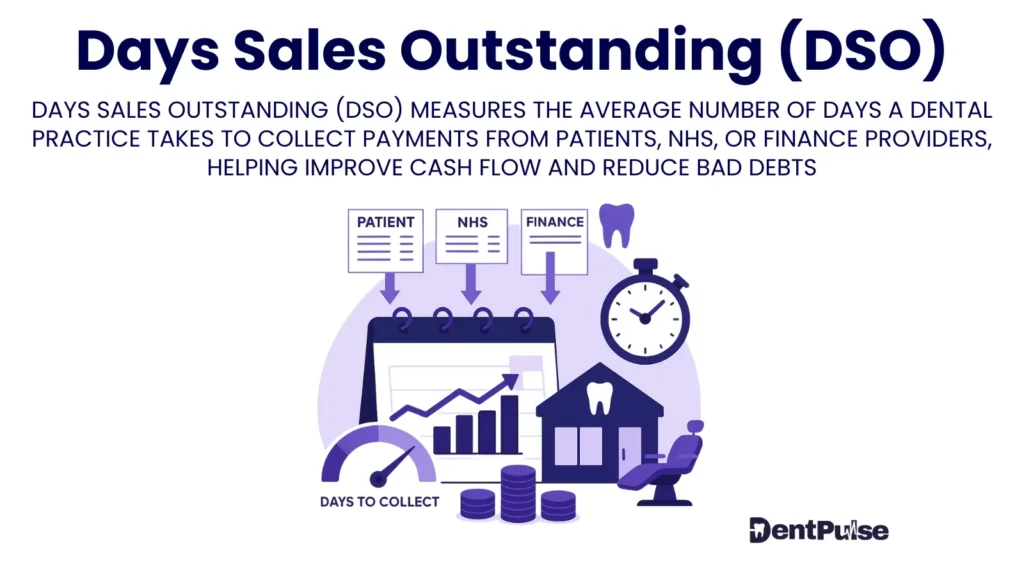What Is Days Sales Outstanding (DSO) in Dental Practices?
Days Sales Outstanding (DSO) is a financial metric that measures how many days it takes, on average, to collect payment after completing a treatment.
It reflects how efficiently your dental practice converts invoiced or earned income into cleared cash — and is a key indicator of cash flow health and payment discipline.
Why DSO Matters for Dental Practice Owners
You don’t go broke because of lack of revenue — you go broke waiting for it.
A high DSO means:
- You’ve earned income, but it hasn’t hit your bank
- Your cash is trapped in patient payment plans, unpaid NHS claims, or late associate receivables
- You’re funding operations while waiting to be paid
Example:
If your average DSO is 45 days and you generate £100K/month in treatment income, £150K is sitting in unpaid balances — putting stress on your buffer and tax obligations.
Lowering DSO improves liquidity without needing to grow revenue.
How Is DSO Calculated?
| Formula | Explanation |
| DSO = (Accounts Receivable ÷ Total Credit Sales) × Number of Days | Shows how long (on average) it takes to collect money after treatment is delivered |
Use 30 or 90-day rolling windows for trend analysis
🦷 In dental practices, “credit sales” = earned income that hasn’t cleared yet
What Contributes to High DSO in Dental Clinics?
| Cause | Impact |
| Payment Plans | Slower cash conversion from aligners, implants, etc. |
| NHS Delays | Quarterly payments vs. monthly outgoings |
| Associate Split Lag | Paying associates before collections are cleared |
| Insurance/Finance Gaps | External delays outside your control |
| Weak Follow-Up | Lack of overdue patient balance management |
DentPulse breaks these down by source — not just one big AR number.
How DentPulse Tracks and Optimises DSO
| Feature | Function |
| Treatment-Based AR | Measures DSO from the date of treatment, not invoice |
| DSO by Revenue Type | NHS, private, plan, associate receivables tracked separately |
| Income Lag Alerts | Flags when DSO exceeds 30-day and 60-day benchmarks |
| CFFP™ Integration | Tests whether forecasted inflow timing is aligned with outflow pressure |
| Debtor Risk Zones | RAG-scored receivables help prioritise follow-up |
DentPulse lets you see, segment, and solve DSO issues — with clarity and confidence.
DentPulse Tip™
Revenue means nothing if it never hits your bank.
Every extra day of DSO is a silent drain on your working capital.
DentPulse helps you shorten the gap and strengthen your buffer — without chasing growth.
Related Glossary Terms
- Accounts Receivable (AR) – Income earned but not yet received
- CFFP™ – Cash Flow Future Pairing – Forecasts inflow against real payment timing
- 12-Week Cash Buffer – The safety window DSO puts at risk
- MCBTP™ – Minimum Cash Balance to Protect – Buffer breach alert tied to DSO
- Cash Flow Gap – Created when DSO extends beyond outflow timing
Glossary Summary Table
| Term | Meaning |
| Days Sales Outstanding (DSO) | Average number of days it takes to receive payment after delivering treatment |
| Formula | (AR ÷ Credit Sales) × Days in Period |
| Risk | High DSO = cash trapped, delayed buffer recovery, tax risk |
| DentPulse Advantage | Tracks DSO in real time by treatment type, highlights lag risks, links directly to CFFP™ forecasts |




